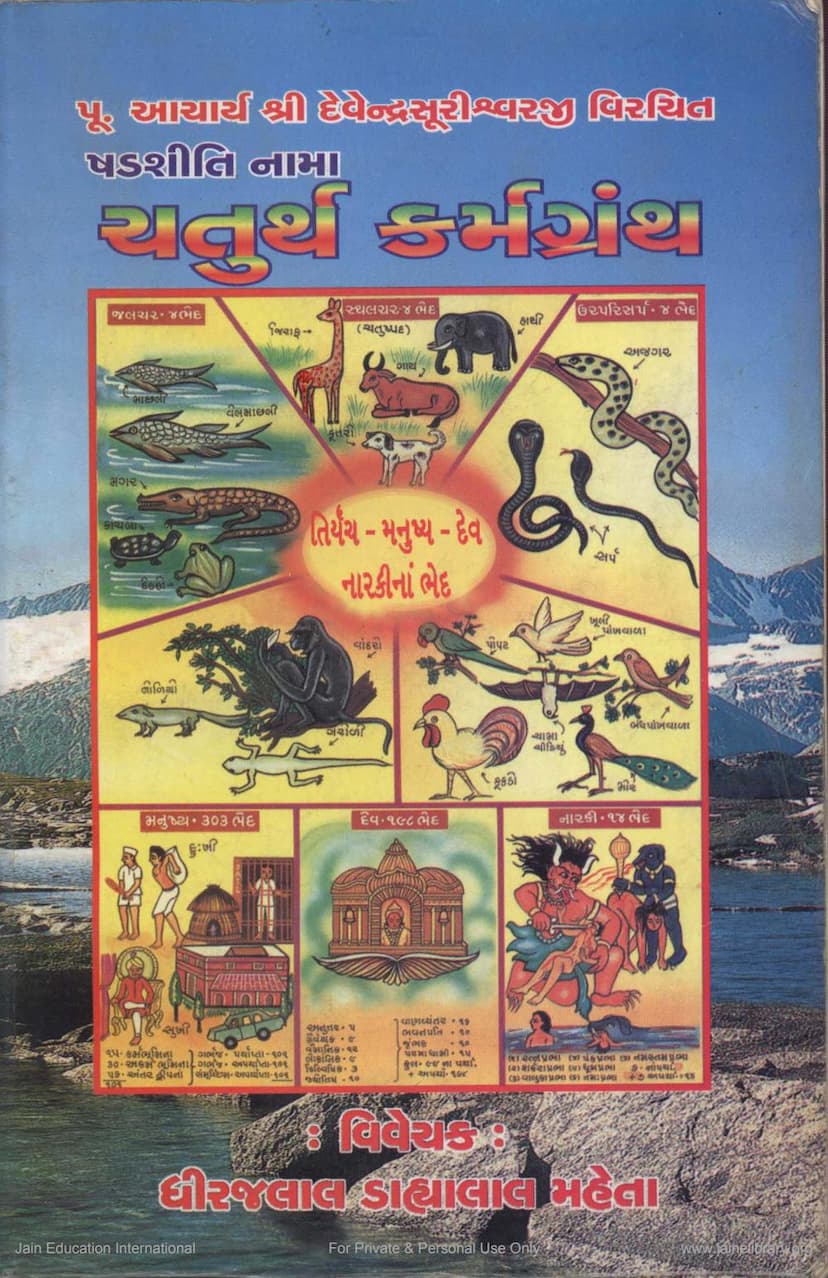Karmagrantha Part 4 Shadshiti Nama Tika
Added to library: September 2, 2025

Summary
Here's a comprehensive summary of the Jain text "Karmagrantha Part 4 Shadshiti Nama Tika" by Acharya Devendrasuri, with commentary by Dhirajlal D. Mehta:
Overview:
This volume, "Karmagrantha Part 4: Shadshiti Nama Tika," is the fourth in a series of Jain texts dealing with the science of karma. Authored by the esteemed Acharya Devendrasuri and elucidated with commentary by Dhirajlal D. Mehta, it serves as a detailed explanation of the "Shadshiti Nama" (meaning "Eighty-Six") text, which itself is part of a larger framework for understanding Jain philosophy, particularly concerning karmas. The book was published by the Jain Dharm Prasaran Trust in Surat.
Key Themes and Content:
Unlike previous volumes in the Karmagrantha series that focus directly on the nature and types of karmas, this fourth volume takes a different approach. While it touches upon karmic principles, its primary focus is on explaining fundamental Jain cosmological and philosophical concepts that are essential for a deeper understanding of karma. The text is structured into five main parts, each corresponding to groups of gathas (verses):
-
Gathas 1-8: Jiva Sthanakas and the Eight Doors: This section introduces the fourteen fundamental classifications of living beings (Jiva Sthanakas), ranging from one-sensed beings (ekendriya) to five-sensed beings (panchendriya). It then elaborates on how various karmic principles apply to these classifications through the lens of "eight doors" (aath dwar). These doors likely refer to categories like guna sthana (stages of spiritual development), yoga (modes of action), upayoga (consciousness), leshya (subtle karmic colors), and the states of bondage, eruption, effluvium, and persistence of the eight karmas. This section aims to develop the reader's perspective and refine their intellect.
-
Gathas 9-44: Margana Sthanakas and Six Doors: This extensive section begins by defining the fourteen fundamental margaṇa sthanakas (categories for analyzing beings) and the sixty-two secondary margaṇa sthanakas. It then delves deeply into applying six "doors" to these sixty-two margaṇas: jiva sthana, guna sthana, yoga, upayoga, leshya, and alpa-bahutva (comparative quantities). Understanding these margaṇas is crucial for entering any Jain scripture and engaging in religious discussions with depth. It helps clarify what exists and what doesn't in different contexts.
-
Gathas 45-63: Fourteen Gunathankas and Ten Doors: This part focuses on the fourteen guna sthanakas (stages of spiritual development). It analyzes these stages through ten "doors": jiva sthana, yoga, upayoga, leshya, bandha hetu (causes of karmic bondage, with a detailed explanation of 57 such causes), bandha (bondage), udaya (eruption), udīraṇā (effluvium), sattā (persistence of karma), and alpa-bahutva. The text aims to make fundamental Jain principles accessible to beginners by explaining the complex web of interactions (bhangajaal) of single and multiple beings.
-
Gathas 64-70: Five Bhavas and Their Variations: This section explains the five fundamental states of existence (pancha bhava) – aupamika (illusionary), kshāyika (destructive), kshayopashamika (mixed destructive-illusory), audayika (eruptionary), and pāriṇāmika (inherent) – and their sub-classifications. It clarifies which states are associated with which karmas and substances, providing immense clarity on the subject.
-
Gathas 71-86: Description of Numbers (Sankyata, Asankyata, Ananta): This final section deals with the quantitative aspects of Jain philosophy, explaining the concepts of sankyata (countable), asankyata (uncountable), and ananta (infinite). It details twenty-one variations within these categories, using the analogy of measuring quantities with four pitchers (chatuh pyala ki rashi) as a fascinating method to grasp seemingly inconceivable numbers and principles. The author's elegant style in explaining these abstract concepts is highly praised, inspiring reverence for the ancient maharishis.
Overall Purpose and Significance:
The book emphasizes that while the core subject is karma, the fourth Karmagrantha incorporates numerous related but distinct topics. By weaving these together, it aims to broadly disseminate knowledge among disciples. The understanding gained from these discussions is deemed highly beneficial for studying the fifth and sixth Karmagranthas and comprehending the intricacies of various karmic permutations (basariya na bhanga).
The commentary highlights the immense effort of Acharya Devendrasuri in making foundational Jain principles understandable to students. It also acknowledges the indebtedness to prior works and commentators, including the svopajña tika (author's own commentary), ṭabā, bālābodha, and the commentary from the Mehsana Pathashala.
Commentary and Editorial Contributions:
The commentary by Dhirajlal D. Mehta is noted for its simplicity and clarity in Gujarati. The research and meticulous review by Pandyt Shri Abhayshekhar Vijayji Maharajshri are also acknowledged, indicating a collaborative effort to ensure accuracy and accessibility. The publication of this work is seen as a significant contribution to Jain literature, making complex philosophical concepts available to a wider audience.
In essence, "Karmagrantha Part 4: Shadshiti Nama Tika" is a pivotal text in the Karmagrantha series, acting as a comprehensive primer on essential Jain cosmological and analytical categories (like Jiva Sthanakas, Margana Sthanakas, and Guna Sthanakas) that form the bedrock for understanding the intricate science of karma. It bridges the gap between foundational knowledge and advanced karmic study.